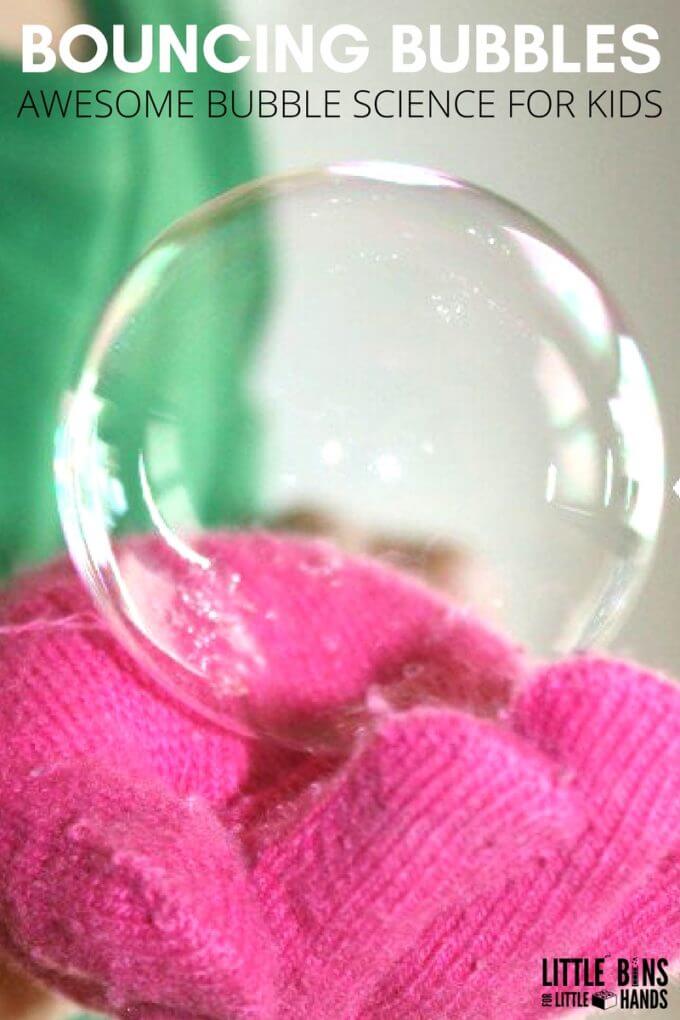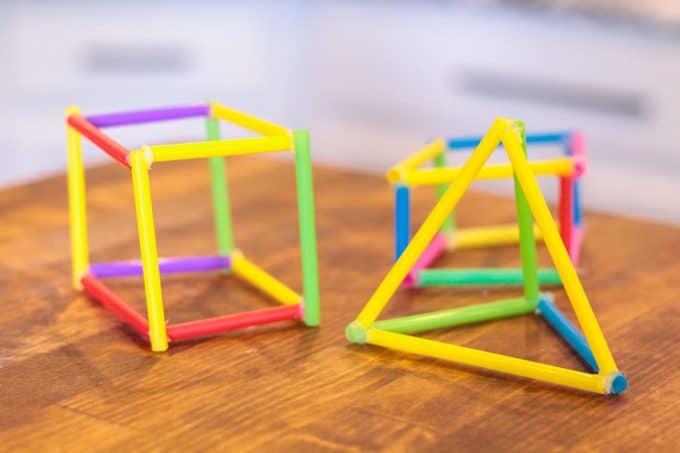Looking to forgo store-bought bubbles this year? Creating the best homemade bubble solution can be a fun and rewarding activity for kids of all ages. Making large, sturdy, and long-lasting bubbles requires a little experimentation with ingredients. In this bubble-making guide, we’ll cover everything you need to know to make the perfect bubble solution for kids to blow giant bubbles. Test out two homemade bubble recipes and see which bubble mixture you like better. You can even turn it into a science experiment for older kids.
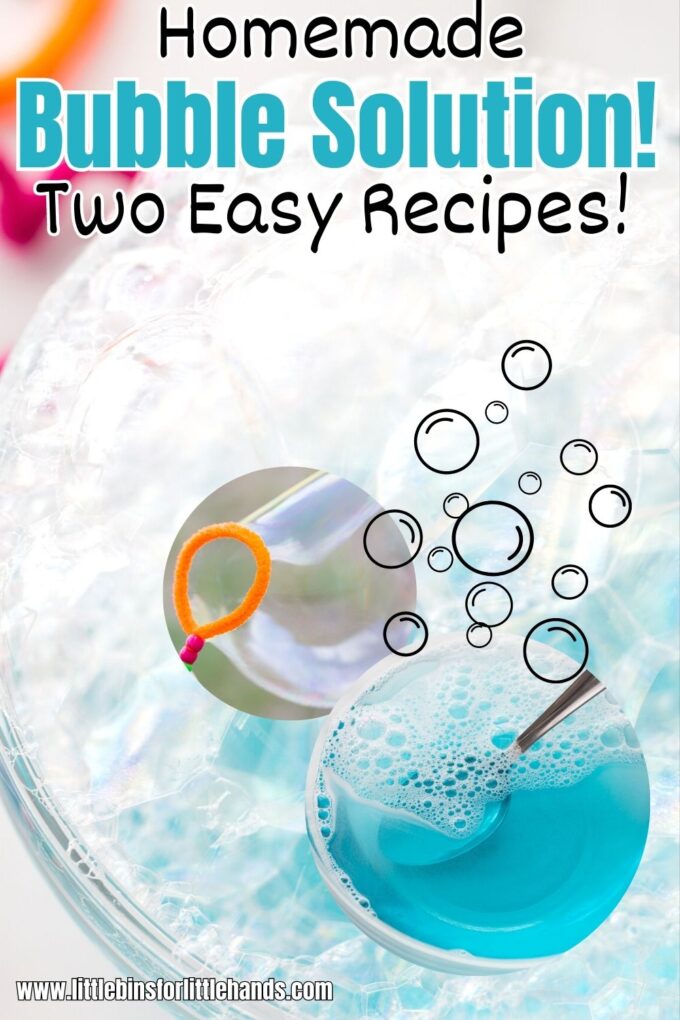
Easy Bubble Science for Kids
Before we try out an easy recipe for DIY bubble solution, let’s understand the science behind bubbles. Bubbles are formed when a thin film of liquid (in this case, your bubble solution) traps a pocket of air inside it. The surface tension of the liquid film is what holds the bubble together. To create bigger and more durable bubbles, we need to improve the surface tension of the bubble solution.
DIY bubbles are fascinating and delightful for kids to explore, and they offer a perfect opportunity to introduce basic scientific concepts in a fun and interactive way. Instead of heading to the dollar store this summer for bubble solution, make a homemade solution!
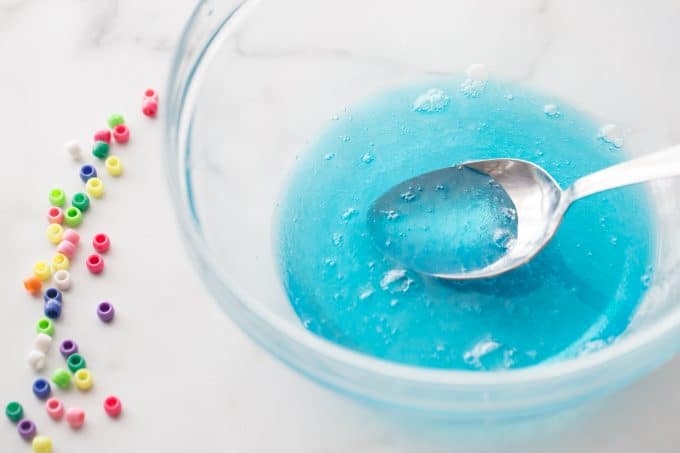
Is Glycerin or Corn Syrup Better for a Bubble Solution
Using either glycerin or corn syrup as an extra ingredient in your own homemade bubble solution can enhance the quality of the bubbles, but each has its advantages and disadvantages. Here’s why you might choose glycerin over corn syrup:
- Bubble Strength and Longevity: For strong bubbles, glycerin is generally more effective than corn syrup in increasing the strength and longevity of bubbles. Glycerin is a clear, odorless liquid that is highly viscous. Adding to the bubble solution increases the thickness (viscosity) of the liquid film, making the bubbles more durable and less prone to popping quickly. This is especially important for creating big bubbles that can withstand gentle handling and last longer before evaporating.
- Non-Sticky Solution: One advantage of glycerin is that it leaves less residue compared to corn syrup. Corn syrup can make the bubble solution slightly sticky, which may be undesirable for some users, especially when bubbles land on surfaces or skin. Glycerin, on the other hand, is less likely to leave a sticky residue, resulting in a cleaner and more pleasant bubble-blowing experience.
- Better Performance in Dry Conditions: Glycerin-based bubble solutions tend to perform better in dry weather or low humidity conditions. When the air is dry, bubbles made with glycerin are less likely to evaporate quickly, allowing them to last longer and float in the air gracefully. In contrast, corn syrup might not provide the same level of performance in dry conditions due to its stickiness and lower viscosity.
- Easy to Find and Mix: Glycerin is widely available in most drugstores, supermarkets, or online, making it easily accessible for creating bubble solutions. It also blends well with water and dish soap, resulting in a smooth mixture without much effort.
While glycerin has these advantages, it’s important to note that corn syrup can still be a viable option for making bubble solutions. Corn syrup is readily available and can also improve the strength of bubbles, although to a slightly lesser extent compared to glycerin.
Additionally, some people prefer using corn syrup because it is food-safe and non-toxic, which may be a consideration if young children are involved in bubble play.
Ultimately, the choice between glycerin and corn syrup comes down to personal preference and the desired properties of the bubble solution. Both ingredients can enhance the homemade bubble recipe, and it’s fun to experiment with different proportions to find the best recipe for your kids to blow the biggest bubbles!
How to Make Bubble Solution with Glycerin
Glycerin helps create strong, long-lasting bubbles that are perfect for bubble play. Here’s a simple recipe to make your own bubble solution using glycerin:
Basic Ingredients and Supplies Needed:
- 1 cup water
- 1/4 cup dishwashing liquid (mild and free from additives like moisturizers)
- 2 tablespoons glycerin
- Mixing container
- Measuring cups or spoons
- Bubble wands or blowers
Instructions:
- Gather your ingredients and equipment.
- Measure the water and pour it into the mixing container.
- Add the dish soap to the water. Make sure to choose a mild dish soap without any added moisturizers or lotions, as these can affect bubble formation.
- Measure the glycerin and add it to the mixture. Glycerin is often found in the baking or pharmacy section of stores.
- Gently stir the ingredients together. Avoid creating too many bubbles or foam while stirring, as this can affect the quality of your bubble solution.
- Let the bubble solution rest for at least an hour or even overnight. Allowing the ingredients to blend and settle improves the performance of the bubbles.
- Test the bubble solution by using your bubble wands or blowers to blow bubbles. Check if the bubbles are sturdy and long-lasting.
- If the bubbles don’t meet your expectations, you can adjust the proportions of the ingredients. For stronger bubbles, you can add a bit more glycerin. For larger bubbles, you can experiment with adding more soap.
- Once you are satisfied with the bubble solution, store any leftover bubble solution mixture in an airtight container. Label the container and keep it in a cool, dry place for future use.
- Before each use, give the container a gentle shake to remix the ingredients.
Free Printable Bubble Solution Recipe with Corn Syrup
Print out the free bubble solution recipe and play guide here.
How to Make Bubble Solution with Corn Syrup
Making a homemade bubble solution with corn syrup is another excellent option for creating sturdy and long-lasting bubbles. Corn syrup adds viscosity to the solution, making the bubbles more robust and less prone to popping quickly. Here’s a simple recipe for making a bubble solution using corn syrup:
Watch the video tutorial here for bubble solution with corn syrup.
Basic Ingredients and Supplies Needed:
- 1 cup water
- 1/4 cup dishwashing liquid (mild and free from additives like moisturizers)
- 2 tablespoons corn syrup
- Mixing container
- Measuring cups or spoons
- Bubble wands or blowers
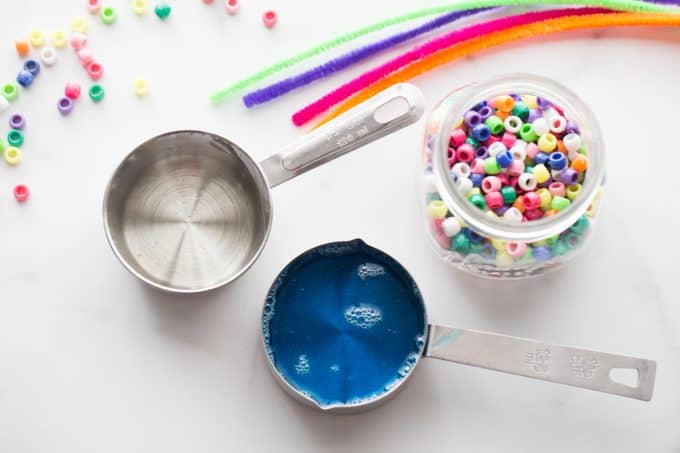
Instructions:
- Gather your ingredients and equipment.
- Measure the water and pour it into the mixing container.
- Add the dish soap to the water. Choose a mild dish soap without any added moisturizers or lotions for the best bubble performance.
- Measure the corn syrup and add it to the mixture. Corn syrup is readily available in most grocery stores.
- Gently stir the ingredients together. Be careful not to create too many bubbles or foam while stirring, as this can affect the quality of your bubble solution.
- Let the bubble solution rest for at least an hour or even overnight. Allowing the ingredients to blend and settle will improve the bubbles’ performance.
- Test the bubble solution by using your bubble wands or blowers to blow bubbles. Check if the bubbles are strong and long-lasting.
- If the bubbles are not up to your expectations, you can adjust the proportions of the ingredients. For more durable bubbles, you can add a bit more corn syrup. For larger bubbles, you can experiment with adding more dish soap.
- Once you are satisfied with the bubble solution, store any leftover mixture in an airtight container. Label the container and keep it in a cool, dry place for future use.
- Before each use, give the container a gentle shake to remix the ingredients.
Tips for Homemade Bubble Solution Recipes
Follow these tips for the best results when making a DIY bubble solution recipe:
- If possible, use distilled water, as plain water (tap) may contain impurities affecting bubble performance.
- Experiment with different bubble wands or an unusual bubble blower to create various sizes and shapes.
- Encourage kids to blow bubbles gently to avoid popping them too quickly.
- Bubble solutions tend to perform better on humid days since moisture in the air helps maintain their shape and prevents them from drying out too quickly.
- For added fun, add food coloring to the bubble solution to create colorful bubbles.
- Remember that bubble solutions work best when they are fresh. If you notice the bubbles losing their quality over time, it might be time to make a new batch.
What are bubbles?
Bubbles are thin liquid films enclosing a pocket of air or other gas. They can be made from a water and soap mixture or other liquids with appropriate properties (including the addition of glycerin or corn syrup). The film of a bubble is made up of water molecules (in the case of soap bubbles) and is very flexible, allowing it to trap the air inside. Did you know a bubble has three “walls” like a sandwich? The outer walls are a thin layer of soap with a layer of water sandwiched in between them.
How are bubbles formed?
Bubbles are formed when air (or another gas) is blown into a liquid that contains soap or other substances that lower the liquid’s surface tension. Surface tension is the force that holds the molecules of a liquid together, creating a thin, elastic “skin” on its surface. Blowing air into the soapy water stretches the surface tension of the water mixture to form a sphere, creating a bubble.
Why are bubbles round?
Bubbles are round because the sphere is the shape with the least amount of surface area for a given volume. In nature, many things try to minimize energy, and a sphere is the most energy-efficient shape for enclosing a given volume of air.
Popping bubbles:
Bubbles can be easily popped by touching them or when they come into contact with dry surfaces. This happens because the water in the bubble film evaporates (remember the sandwich from above), causing the film to thin and break. When the bubble pops, the air inside is released into the atmosphere.
Try bouncing bubbles for a neat bubble science activity!
What affects bubble size and longevity?
Blowing different types of bubbles: Kids can have fun blowing bubbles of various sizes and shapes. For larger bubbles, use a giant bubble wand or create your own using a loop of string attached to two sticks.
For smaller bubbles, use a traditional wand—experiment with blowing bubbles inside other bubbles or creating bubble snakes using a sock and a plastic bottle.
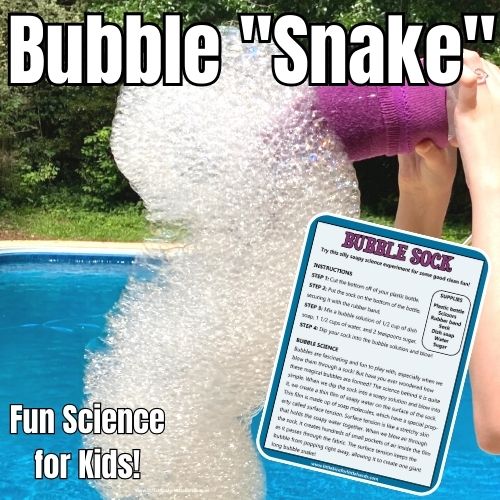
Why do bubbles have rainbows?
When light passes through a bubble, it can create vibrant colors on the surface of the bubble. This phenomenon, known as “interference,” happens when light waves bounce off the inner and outer surfaces of the bubble’s film. Kids can observe these colors by holding bubbles up to the sunlight.
Make bubble sculptures:
Encourage kids to experiment with creating bubble sculptures by using various materials to shape and mold the bubbles. For instance, a bubble can be trapped inside a straw or on the edge of a pipe cleaner, forming different shapes. Try these bubble tower cups!
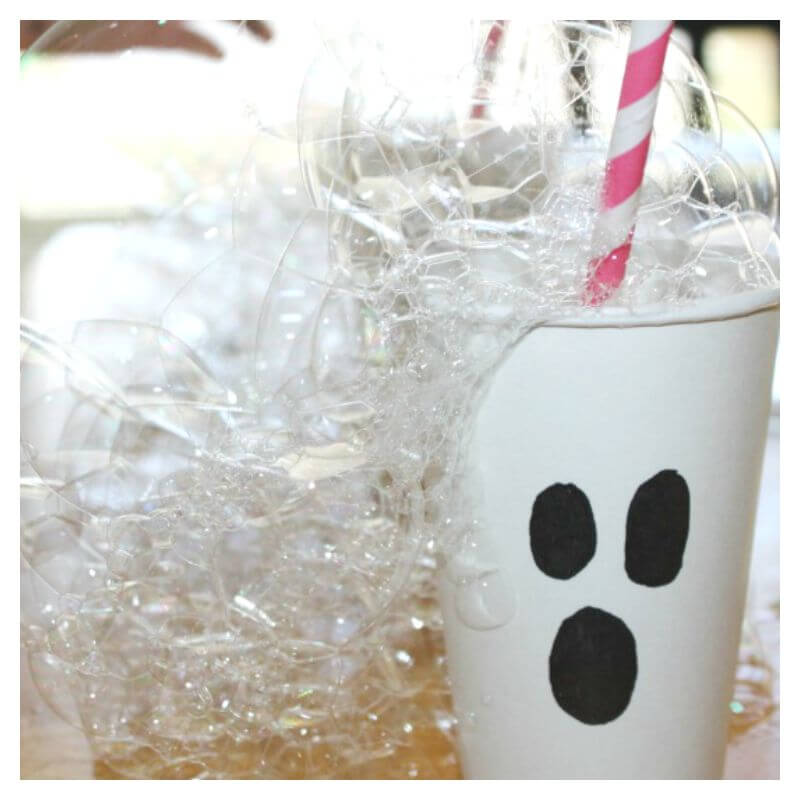
Make Bubble Wands or Bubble Shapes:
Can you make different shape bubbles? Try this fun bubble STEM activity! Make geometric shape DIY bubble wands, and then try these 3D bubble shape frames.
Try bubble painting:
Kids can use colored bubble solutions or add food coloring to their bubbles to create beautiful bubble art on paper. They can blow bubbles directly onto the paper, catch them on the bubble wand, and then press them onto it. Add this bubble activity to your summer bucket list!
Bubble volcanoes:
Create a fun bubble volcano by mixing baking soda and vinegar inside a container. Add bubble solution to the mix, creating a bubbly eruption like a real volcano. Take it outside too!
Through bubble science, kids can explore concepts like surface tension, water evaporation, light interference, and more in a playful and hands-on way. Encourage them to ask questions, make predictions, and conduct simple experiments to deepen their understanding of the science behind bubbles. Most importantly, let them have fun while learning and exploring this magical world of bubbles!
Make a Bubble Science Fair Project
Experiment with both types of bubble solution and use your finding to create a science fair project or presentation. Learn more about setting up science fair projects and creating science fair boards to get started.
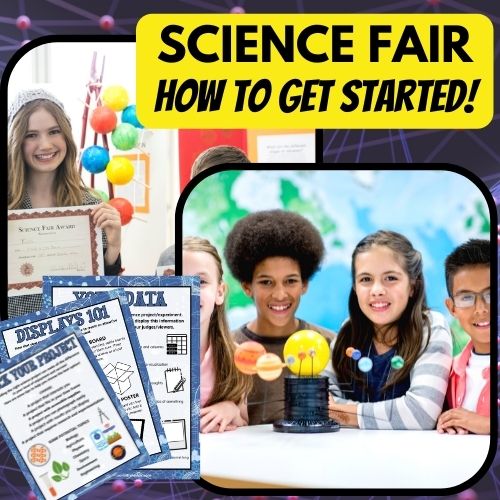
Printable Science Projects For Kids
If you’re looking to grab all of our printable science projects in one convenient place plus exclusive worksheets and bonuses like a STEAM Project pack, our Science Project Pack is what you need! Over 300+ Pages!
- 90+ classic science activities with journal pages, supply lists, set up and process, and science information. NEW! Activity-specific observation pages!
- Best science practices posters and our original science method process folders for extra alternatives!
- Be a Collector activities pack introduces kids to the world of making collections through the eyes of a scientist. What will they collect first?
- Know the Words Science vocabulary pack includes flashcards, crosswords, and word searches that illuminate keywords in the experiments!
- My science journal writing prompts explore what it means to be a scientist!!
- Bonus STEAM Project Pack: Art meets science with doable projects!
- Bonus Quick Grab Packs for Biology, Earth Science, Chemistry, and Physics


